
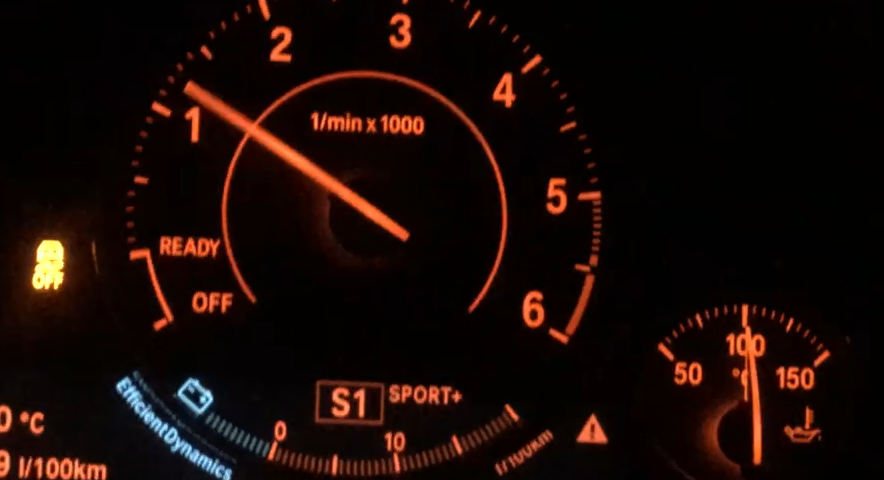
LAUNCH CONTROL What it does and not does!
Since introduction of our first Maps for the F-Series x35i (N55) cars in January 2019, there is one question popping up constantly: "Does xHP add Launch Control (LC) to my car?" Short answer: Yes. But there's a more elaborate one as well. Today we'll be trying to tackle the most common questions and misunderstandings around the LC function. First, lets start what LC actually is. BMW added the LC mode to their vehicles around Summer 2013. (Press Release: bit.ly/2uUFCq4)
The Press Release from back then also describes "LC" as a measure to "accelerate with optimal drive slip". Thats a pretty broad description and does not tell what actually has changed from a technical point of view. From the driver's seat, the first difference is the fancy checkered flag in the dash, together with the sentence "Launch Control Active", when carrying out the procedure noted in the Press-Release. In a nutshell: Vehicle must be fully warmed up, steering wheel straight, doors closed, no trailer attached (yes...that actually gets checked), put your gear lever to "S", press the DSC button once or go to Sport+, press the brake pedal VERY hard, quickly go full throttle, release the brake after around 1 - 2 seconds. There you got it, your BMW accelerates. How exciting. For people having LC from factory, you can even read it up in the user manual on the iDrive ( https://bit.ly/2UGyiN4 ) and here's a Video from BMW explaining the usage. ( https://bit.ly/2FSdYPi ) Unfortunately I found it only in German, but I think you get the idea anyway. (Note: The procedure is different on cars with Double-Clutch-Transmissions)
So now we know how to activate it, but what's going on under the hood? There are a few of the car's computers involved to make it happen, but most important are the DSC (Stability Control) and the Transmission. Both have to work together for an optimal launch. The DSC needs to be set to "Traction"-Mode. Initially, this mode was meant for Winter-Driving and is there on BMW's for ages, but has been of course refined more and more over time. It allows the wheels to slip quite a bit, before actually cutting power. Optimal Traction is generated in a tiny slip area, when the vehicle's tyres spin around 10-20% quicker than the vehicle itself is actually moving. The root sits in the chaining effects of the rubber with the underlying surface, which are optimal with some slip. Of course the optimal amount of slip and the grip in general vary with temperature, tyres, tyre pressure, surface etc. etc. Thats why it's so hard to match manufacturer 0-60 times with a stock car...they take care the outside conditions are perfect when measuring. Hard to re-produce on a random road on a random day. It's hit and miss. The second important unit is the transmission, taking care of optimal shift times and torque transfer on your way to 60 Mph.
What the ZF 8-Speed Auto actually does in Launch Mode is to engage a different shift mode, which is only active when the aforementioned procedure is carried out. The characteristic of this mode can be described as "i-don't-care-about-my-clutches-mode". Yes, LC mode makes your transmission wear. Thats the reason, there is an undocumented limit of 50 launches built in to the ZF transmissions. After 50 launches the trans will silently never engage that mode again. How do we know that? Because we don't look at documentations, we reverse-engineer the transmission's code to understand whats going on inside. It's also that exact mode, that is added to pre-2013 cars, when they get flashed with xHP. Even if you have a BMW before Summer 2013, the flash with xHP will update the transmission to the most recent software, which has the LC routine built in. There's only one "downside": You won't see the flag in the dash still, as that flag is not triggered through the transmission. Eventually it can be activated on the older cars with some coding in other modules, but technically it does no difference, wether there is a flag or not.
But there are more things to consider with LC, when running a car that isn't really stock. There's for example the procedure with pressing the brake and flooring the throttle. On a DCT transmission the trans would be in idle position in that situation and there wouldn't be any power-flow to the rear wheels unless you release the brake. On a torque converter Automatic like the ZF8HP, there is always power-flow to the rears, as soon as you are in D/S or M mode. This means when going full throttle the engine will be instantly transmitting torque to your rear wheels and the brake has to overcome that momentum to keep the car standing still. This works without issue on a stock car, but on tuned cars with lifted torque limiters the engine can actually outpferform the rear brakes and they will start to spin, no matter how hard you press the brake. This does not mean LC is broken, this does only mean your rear brakes can't hold the power anymore.
The solution is simple: Don't let the car boost that high, before releasing the brake. Just release the brake quickly, around 1 sec after going full throttle. This is also a major difference between LC mode on a DCT (Double-Clutch) Transmission and a Torque-Converter Auto. With the DCT the procedure holds a certain pre-set RPM (that's what creates that crazy sound on M-Cars) before dumping the clutch once the driver releases the brake. On a torque converter trans the engine just presses with maximum force against the torque converter until you release the brake. So the RPM you reach while standing still is not controlled. It's just the outcome of engine power vs. the torque converter. (means the RPM will vary depending on engine power) So once the car is tuned, it is to some extent the drivers responsibility to release the brake at the right time.
The next issue is the Traction Control during accleration itself. This is a tricky task as there is no perfect world, where each launch is the same. Actually the DSC has to monitor wheel spin hundreds of times a second and reduce/raise engine power all the time to keep the wheels in the optimal slip range. The engineers configure this process in the DSC for a stock car, with stock power level and stock suspension. Changing the tyres to a very different size, fitting an aftermarket coil-over suspension, or running 100 HP more than stock will all offset this calibration and in the end you can be left with a worse 0-60 than stock.
Last but not least, tuned vehicles offer a different power band, which has influence on the optimal Shift-RPM. Again, the RPMs to shift during LC mode are configured for a stock engine and yes, they will change with tuned engines. By how much depends on the engine tune. People with a Stage 1 tune will likely even benefit from lower Shift-RPMs compared to stock, people with bigger aftermarket turbos may need higher Shift-RPMs. This can only be determined on car by testing. (or by pre-calculating based on a proper dyno sheet)
All issues described above can be tackled with the Custom Module inside xHP. The "Torque-Limit per Gear" function takes care of the first two issues. It allows you to set the maximum allowed torque for 1st Gear. As standard, those limits are set to maximum (1000 - 1200 Nm@Crank) in our maps, but we already included presets for different situations, which you can use as a starting point to find your personal best setting. The last issue will be gone with the next release of xHP, where people will be able to set their Shift-RPMs during LC mode. Please note, that all of this works exactly the same on the ZF 6-Speed Autos, but they do not have the special super-hard shifting mode for LC.
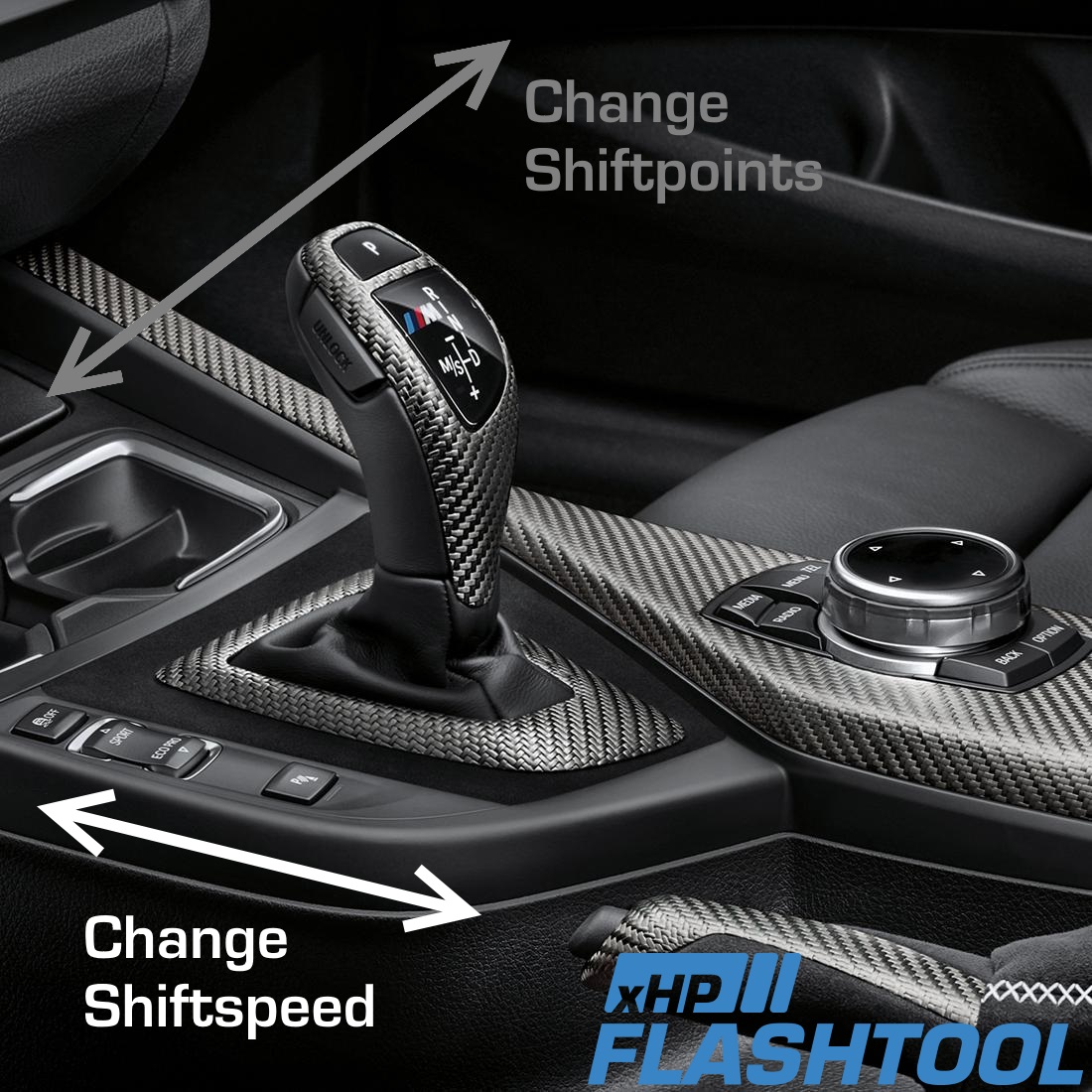
HOW XHP CHANGES THE SPORT BUTTON AND THE CHARACTER OF YOUR 335I F-SERIES BMW! The 8HP is an extremely competent transmission, how do you make that even better?
Last week (Jan 21st 19) we released our first 8-Speed Transmission (ZF8HP) setups for F-Series BMW. First cars to be supported were M135i/M235i/335i/435i and 535i variants. All equipped with the N55 3.0 straight-six turbo-engine and ZF 8HP45 transmission. This is just the first release and of course we will be working our way through the majority of 8-Speed cars, just like we did it with the 6-Speed E-Series BMW. Prior release, a lot of people asked us: "What the hell do you want to improve with the 8-Speed?" 🙂
Well, yes...the 8-Speed is an extremely competent transmission, being able of achieving virtually anything you can imagine. From smooth-as-silk yet reasonably fast shifts, to totally instant and rocket-fastThe shifts with a sportive touch. So, yes...doing maps for it, that we judge being better by ourselves was not an easy task. Actually we spent over 6 months just with Re-Mapping in car. Through this period we accumulated over 10.000 kilometers (approx. 6200 miles) on our F31 test-car, while having the laptop on the passenger seat.
What did take so long? Well, our standard is not to just remove some torque limiters or raise line pressure a bit. Our standard is to actually improve the driving experience you have on a daily basis with your car. Thats what xHP stood for in the past, and thats what we always want to achieve when doing setups. While removing a torque limit or helping the trans to hold a bit more power may be important for the minority of people that run double the stock power on their car, this does not help anything for people with stock power cars, nor will it actually get you more fun when running a car with a bit more power than stock. It gets you a better feeling, that you did the right thing to prolong your transmissions life when running an engine tune, but that won't put a smile on your face every day.
So what do we do with our maps? The answer is simple, the way is complicated: We not only "tune" the transmission, we change the rules how it behaves and how it reacts to driver inputs. Thats where the DEC-Switch comes into play. The majority of F-Series cars come equipped with it. DEC stands for "Driving Experience Switch" and lets you adjust your cars behaviour on the fly from the drivers seat. The settings are Eco-Pro, Comfort, Sport and Sport+. So unlike as in most E-Series 6-Speed cars, where the transmission had a fixed map set for D-Mode, S-Mode and M-Mode, we can now combine those modes in the F-Series cars with the 4 positions of the DEC switch. This gives you a total of 12 operating modes, you can access instant from your driver seat.
Just like you aren't in the same mood every day, your car does not have to be the same every day. It can run full economy style on your commute to work in traffic-jam, while at the same time can be a total beast with rocket-fast shifts and intense throttle-blipping on downshifts just with the flip of a button. That is an awesome tool made by BMW, so people can adjust their cars to their likings. But now starts the "bad" news: BMWs are made for a wide-spread of people/target groups and yeah...they do make compromises, even if all options are at hand. In general, only their M-Cars get the full potatoe. Everything else gets restricted a bit here and there. This means you don't get the last bit of performance on a lower model, even if the transmission could do it. Or they restrict the amount of modes you can access through the DEC, just because marketing-department says: "No, thats too extreme for that target group".
So let's explain it with an example: The 335i (same goes for M135i and M235i) accesses the same transmission mode, when putting the gear-lever in S or when setting the DEC to "Sport" but leaving the gear lever in D. The trans is still "slow" in both modes but you get a bit higher shift-points. Thats not so exciting at all. Or another example is the manual mode: No matter what you have set with the DEC, it will always shift in the fast mode and rough. Some may like it, but it definitely restricts what the system could do.
Our Stage 2 calibration follows a simple rule: The gear lever changes the Shift-Points, while the DEC changes your Shift-Speed. You can combine it totally freely and make full use of what the transmission can do and not what marketing-department thought you should be able to do. Actually thats the way BMW does it in their M-Cars and thats the way we think it should be. So now that we have all modes accessible, what is that good for?
Answer: You now have 3 different shift programs available in every operating mode. For instance, combining normal daily-drive shift points with rocket-fast shifts, creates a pretty awesome experience. You can feel all the torque the N55 creates in the lower to mid-range, while the shifts are so fast you can't even notice any lag between gears. On top, the trans creates that little bangs through the exhaust on every gear change. Or you now can access the fastest shifts possible in S-Mode with full auto-operation and do not have to use M-Mode for that. Last but not least you can also run your transmission in full manual mode but don't need to get your head jolted at each shift. Just use M+Comfort and the trans will shift reasonably fast but very smooth.
Adding to this are hundreds of other small changes, that will make the trans a bit more driver-oriented and not so much economy focused. Being it accessing 8th Gear later in D mode (that lugs the N55 a bit) or showing you the actual gear always on the Dash. Even in normal D-Mode. It's too much to list and sometimes a bit hard to explain, without going into full detail of the trans logic, but in general our setups are generated through driving, driving, driving and not just by drawing lines or raising values at the computer.
The Stage 3 file builds on top of that, but makes S combined with the Sport+ setting ready for roll-racing and the racetrack. As soon as you engage this mode, the trans will keep your RPMs above 4000 and won't upshift below 6500 RPM. This is especially useful in situation where you want maximum acceleration withouth having to think of the right gear by yourself. This mode can also be used on the Race-Track. It will shift just like a race-driver with a stick would do it. Hold gears all the time til the upper rpm range and aggressivly blip down by itself when braking into corners.
You don't like all that? You think BMW already made it perfect for you, but you still need to get rid of the torque limiters in 3rd and 6th gear, so your engine tune can fully deliver? Then the Stage 1 is the right one for you. It keeps stock behaviour in all modes, but raises line pressure for high power cars and sets your torque limits to > 1000 Nm (which, of course, Stage 2 and 3 do as well).
xHP customers can always choose between all 3 Maps. A Map change is only 40 seconds away!
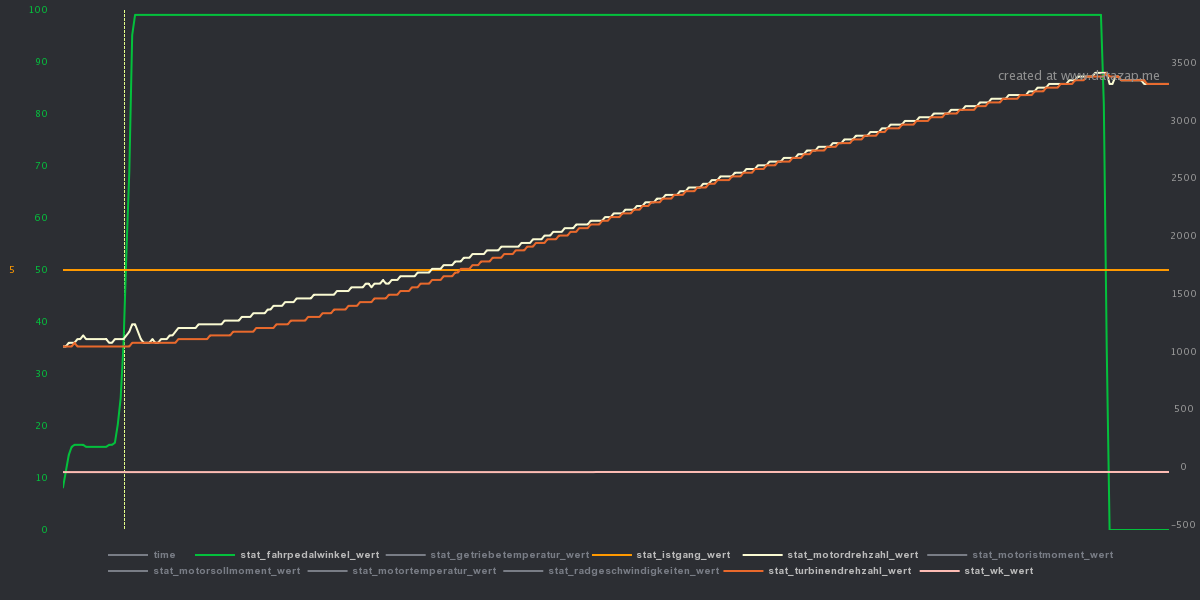
TORQUE CONVERTER The Root of all Evil?
A lot of xHP customers go for our tunes, because they want to get rid of the sluggish feeling, automatic transmissions often have built in. Especially on Diesel applications, the factory setups slip a lot in the first 3 gears, which makes the car feel like it was pulled by an invisible "rubber-band" instead of a proper engine.
While this ensures a very comfy ride on low loads, it turns into the opposite with anything above 25% throttle. The transmission starts to slip a lot and lets the engine rev unnecessarily. Instead of proper acceleration, you get bad mileage and heat in the transmissions oil. The Lock-Up clutch is opened in that situation, so all torque only gets transfered through the torque converters oil, but not through a solid connection.
But the Torque Converter, combined with the Lock-Up Clutch can do some pretty awesome things, that aren't really recognized. With the right setup, it can combine the best of both worlds. A direct connection between engine and transmission and precisely controlled slip to aid acceleration.
The Datazap Log below shows a full throttle acceleration from 80 - 120 km/h (50 - 75 mph) in 5th Gear in a BMW 330d with N57 Diesel Engine. For the tech-savy, note the difference between Engine-RPM and Turbine-RPM. As soon as you get on the throttle the Torque Converter Clutch starts to control slip, to help the 330d's Turbo spool more quickly and therefore accelerate faster.
We did the measurement and the difference between "No Slip" and "Controlled Slip" is 0.4 Seconds from 80 - 120 km/h. Your car actually gains nearly half a second from 80 - 120 km/h with a proper Torque Converter Setup.
Of course this can induce extended wear on the Clutch, but the smart ZF6HP uses fine tuned formulas to calculate whats allowed and whats not allowed. The Slip function goes to sleep once a certain temperature in the clutch material is reached. Until that the majority of wear is kept in check through the transmissions oil.
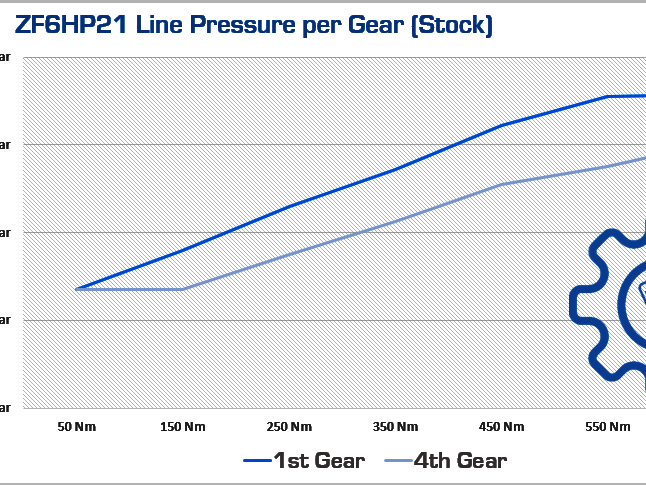
LINE PRESSURE VS. ENGINE TORQUE ... and what this has to do with the durability of your ZF6/ZF8 Auto-Trans!
Auto Transmissions can sometimes play bad with your engine tune, with the outcome of bad shifting, extended slip times or low torque in certain gears. But why is that?
One of the main inputs for the Transmission to do it's job is the engines actual torque. Around 50% of the maps in the TCU use actual engine torque (or some stuff calculated from it) as one of it's inputs. For example Line pressure (thats the base pressure the transmission operates it's clutches with) has a direct relation to engine torque. The higher the torque, the higher the pressure in the trans is and vice versa (of course this is limited within certain boundaries).
So where does it know this "Actual Torque" from? As a car obviously hasn't got a built-in Dyno to measure torque, it must be calculated somehow during operation. This is the job of the ECU. Simply put, it has various maps to factor the actual load situation (based on fuel delivery, boost pressure, ignition angle and many more) and output a calculated torque value from that. This torque value is transmitted to all other units via the Bus-System. One of the most important units (among others) to use that Torque Value is the TCU, you Transmission Controller.
And here's comes the bad news for people tuning their car: All automatic transmissions have "Torque Limits" stored in their TCU. Once the calculated "Actual Torque" breaches the maximum, the TCU will request the ECU to back down boost and stay within this limits. Sneakily, those limits are different per gear. For the ZF6HP the 5th Gear has the lowest value, for the ZF8HP it's 3rd and 6th Gear. (sometimes only 6th Gear) The outcome is power loss, as soon as one of those gears is engaged. (on tuned vehicles)
The common workaround for tunes to operate properly and not hit torque limits, is to "bend" the torque calculation in the ECU, so it well never calculate a value above the transmissions stock limits. Problem solved? Well, not really. Given what's said above, the trans will now operate with wrong clutch pressures. The torque calculation is calibrated to match real world torque very closely. If you alter this calculation, you create an offset between calculated and real world torque, which directly triggers the transmission to operate with too low line pressure.
The effects can be various and are not necessarily recognized instant. Let's suppose your 335i F30 makes around 450 Nm at crank from factory. With a typical Stage 2 tune you add 150 Nm so get 600 Nm at crank. The transmission used is the 8HP45. 45 stands for the suggested max. Torque -> 450 Nm. The electronic limiter sits at 465 Nm, so just a tad above stock torque level. Your tuner now adjusts the torque calculation, so it never triggers this trans limit. The offset between real world and calculation is 150 Nm, or nearly 30%. This means, your transmission will operate with approx. 30% lower pressures, as it would with adjusted torque limits and proper torque calculation.
Short term you may feel that shifting is sometimes a bit off, delayed or not as crisp as it should be. Long term this will lead to extended clutch wear as there is more slip on every shift and even in gear. (Microslip) Adapting the torque limits and using a tune with proper torque calculation will avoid all that AND will increase holding power of your transmission dramatically!
Especially important for people with upgraded Turbos, which are pushing the limits of their platform. The ZF transmissions are incredibly well built and can last forever, even when operated well above stock torque, as long as they are adjusted properly.
For our upcoming 8HP solution, people will be able to chose between a standard map, which keeps 90% stock behaviour but has the torque nannys adjusted, or go for the full solution with a lot of features added.
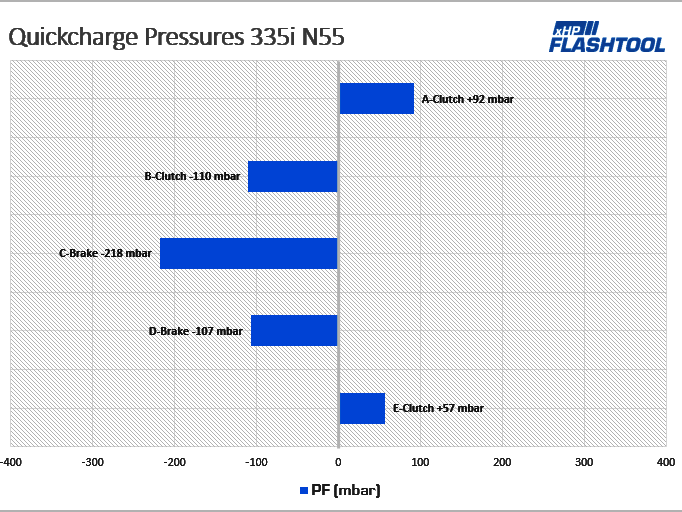
ADAPTIONS The most misunderstood part of transmission control
Since the launch of xHP, nearly 1 year ago, there is the same question popping up every week by customers: “Does xHP reset my transmissions adaptions when flashing?” To cut that short: No, xHP does not reset adaptions and they do not get reset, when flashing the transmission at all. That means, they do not get reset at the dealer either, when you are there for an update. And there are good reasons for it.
First, let’s have a look what Adaptions are and what they are good for. Adaptions basically have two purposes. The very first is to overlay the basic maps, stored in the TCU, by some small offset maps to compensate mechanical/hydraulical tolerances. No transmission is 100% identical to the other in real life and those differences need to be kept in check. So, the aim is to correct the errors in the stored basic setting, if you will.
Secondly, every moving part inside the transmission will wear over it’s lifetime. This is especially true for the clutch packs, which are built to wear by nature. Just like your brake discs wear through friction between disc and pads, so do your clutches (there are 5 of them in the 6HP + the Torque Converter Clutch) on every shift. Don’t panic, most of that wear is controlled through the lubrication with the transmissions oil. That also explains, why oil changes approx. every 60.000 miles are not the worst idea, despite BMW not recommending them. Normally the 6HP’s clutches are good for 200.000 miles and much more. Wear of clutch packs means, they get thinner and thinner over their lifetime.
This leads to the conclusion, the transmission controller has to have a function, to compensate this. Those are the Quickcharge Times and Quickcharge Pressures. They are there to compensate the higher travel, the piston needs to actuate the clutch, before it starts to bite. This is the same principle, employed by your brake system and employed by a manual clutch to compensate for wear. It’s more complicated in the transmission, but the logic is the same.
So, with that knowledge, what is it good for to reset adaptions regularly? Simple answer: For nothing. In rare cases, on transmissions with already very high positive adaptions, this can even lead to a situation, where your transmission will refuse to shift and you basically have to rebuild it, before it will work again. And that is the reason, why adaptions do not get reset by the dealer on service work. There is no reasons for it, unless hardware on the transmission has been changed.
Below you can see how typical (basic) adaption values look like on a 335i car with around 60.000 miles on it. Common min./max. values are -+400 mbar for the Pressure adaption and +-40 ms for the Quickcharge Times. Values above or below are treated as “out of tolerance” but however, transmission can still run and shift "normally" with + 700 mbar as well.
